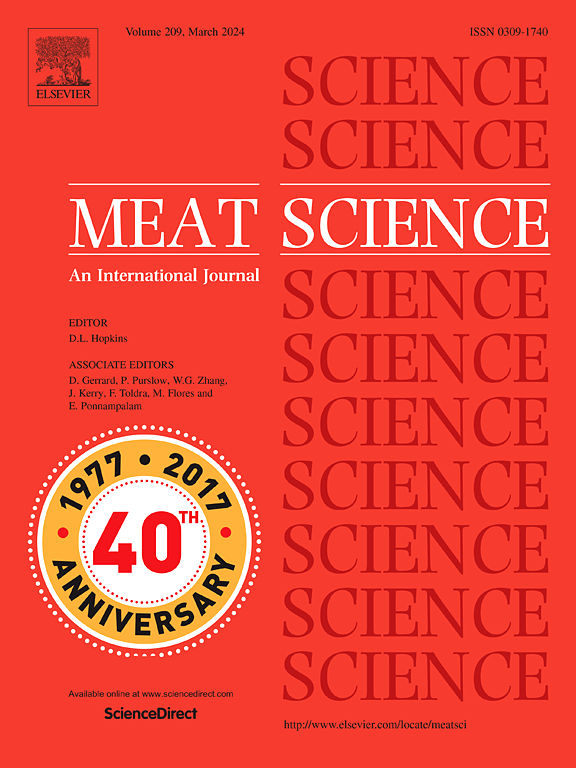Grape seed supplementation in growing rabbits: Effect on meat quality
IF 6.1
1区 农林科学
Q1 Agricultural and Biological Sciences
引用次数: 0
Abstract
Grape seed supplementation in rabbit diet on meat quality and performance was investigated. The experiment lasted 57 days and was conducted with forty Hycole rabbits 35 days-old (bodyweight: 802.6 ± 2.69 g) that were randomly divided into two groups and fed either a control diet (Control group) or the same diet of the control group in which 5 % of barley and 5 % of maize were replaced with 10 % of grape seed (GS group). The dietary treatment influenced final body weight, average daily gain and dry matter intake which were higher (P < 0.05) in the GS group than in the control group. The addition of 10 % grape seed in rabbit diet increased the accumulation of intramuscular fat (P < 0.05), the levels of C18:1 cis-9 (P < 0.01) and of the total monounsaturated fatty acids (P < 0.01), and tended to increase (P = 0.061) the sum of n-6 PUFA in meat, whereas reduced the sum of n-3 PUFA (P < 0.05), the levels of C22:5 n-3 (P < 0.05) and C22:6 n-3 (P < 0.05), leading to an increase (P < 0.01) in the n-6 to n-3 ratio in GS group than in control group. Grape seed supplementation reduced TBARS values (P < 0.01) and protected meat from lipid oxidation over time (P < 0.01), demonstrating that supplementation of 10 % grape seeds in the rabbit diet could improve shelf-life in meat.
生长兔补充葡萄籽对肉质的影响
研究了在家兔饲粮中添加葡萄籽对肉质和生产性能的影响。试验选用体重为802.6±2.69 g的35日龄海高耳兔40只,随机分为2组,分别饲喂对照饲粮(对照组)和以10%葡萄籽代替5%大麦和5%玉米的对照组饲粮(GS组)。饲粮处理对末重、平均日增重和干物质采食量影响较大(P <;GS组与对照组比较差异有统计学意义(0.05)。饲粮中添加10%葡萄籽增加了兔肌内脂肪的积累(P <;0.05), C18:1 cis-9水平(P <;0.01)和总单不饱和脂肪酸(P <;0.01),且有增加肉中n-6 PUFA总量的趋势(P = 0.061),减少肉中n-3 PUFA总量的趋势(P <;0.05), C22:5 n-3水平(P <;0.05)和C22:6 n-3 (P <;0.05),导致增加(P <;GS组n-6 / n-3比显著高于对照组(0.01)。葡萄籽可降低TBARS值(P <;0.01),并随着时间的推移保护肉免受脂质氧化(P <;0.01),说明饲粮中添加10%葡萄籽可提高肉品的货架期。
本文章由计算机程序翻译,如有差异,请以英文原文为准。
求助全文
约1分钟内获得全文
求助全文
来源期刊

Meat Science
工程技术-食品科技
CiteScore
12.60
自引率
9.90%
发文量
282
审稿时长
60 days
期刊介绍:
The aim of Meat Science is to serve as a suitable platform for the dissemination of interdisciplinary and international knowledge on all factors influencing the properties of meat. While the journal primarily focuses on the flesh of mammals, contributions related to poultry will be considered if they enhance the overall understanding of the relationship between muscle nature and meat quality post mortem. Additionally, papers on large birds (e.g., emus, ostriches) as well as wild-captured mammals and crocodiles will be welcomed.
 求助内容:
求助内容: 应助结果提醒方式:
应助结果提醒方式:


